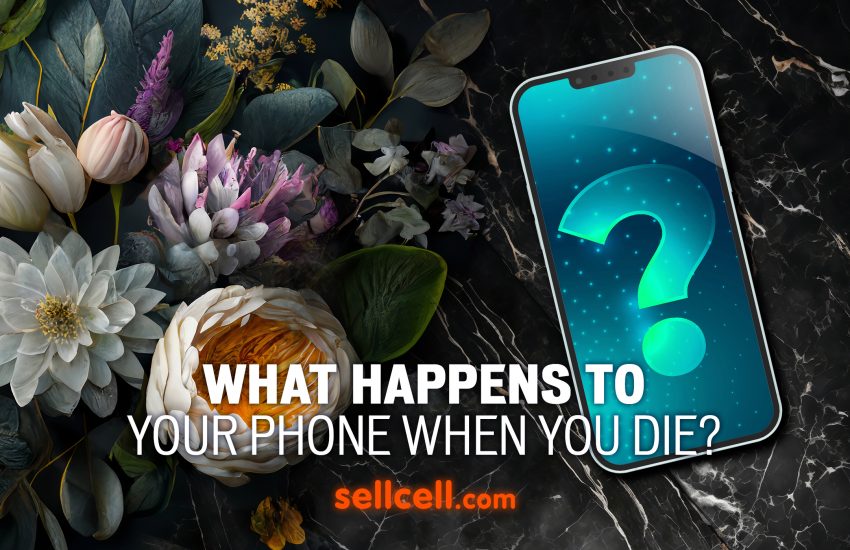Last updated March 14, 2024
Dealing With a Deceased Person’s Digital Legacy
In 2023, 51.5 million people globally left an orphaned mobile phone behind when they died
In the USA in 2023, 3.6 million phones were left behind by those passing away
As of 2023 there are over 30 million Facebook profiles belonging to deceased people, and by 2100 95% of Facebook profiles will belong to deceased people
It might sound like a depressing question to ask, but what happens to your phone when you die? Well, there are several factors that can decide the fate of a smartphone once its owner is no longer with us. The phone itself, the data it holds, and the services it can access are all left behind. Those the phone ends up with might not know what to do with a deceased person’s phone.
While it is never a nice thing to think about, at the end of the day, no phone owner lives forever. And, eventually, our phone becomes an orphan handset. So, what happens to all these phones when we are no longer here to stare at that glowing screen? SellCell has compiled a range of data to look at the various statistics around what happens to your phone when you die. Let’s dive in.
Menu: Jump to a section
- Main Findings
- Summary: What Happens to Your Phone When You Die?
- How Many Mobile Phone Devices Exist, Worldwide?
- How Many Mobile Phone Owners Exist, Worldwide?
- How Many People Die and Leave a Phone, Globally?
- How Many People Die and Leave a Phone in the USA?
- How Can I Plan to Pass My Phone and Contents on Before I Die?
- What to Do With Someone's Phone When They Die: 8 Uses for an Orphaned Handset
- What to Do With a Phone Contract When a Person Dies
- I Can't Get Into the Phone of a Deceased Love One. What Can I Do?
- Tips for Accessing a Deceased Loved One's Phone
- Resetting the Device Without a Password
- Is it Legal to Access a Person's Digital Data When They Die?
- How to Deal With a Deceased Person's Digital Presence: Useful Links
- Leaving a Digital Legacy: What Happens to your Phone (and Your Other Digital Data) When You Die?
- Sources
Main Findings:
- Of the 51.95 million adults who passed away—globally—in 2023, 95% of them (51.50 million) left an orphaned mobile phone behind 1.
- In the US, the figures show a similar trend. 3.71 million adults died, and 97% of them owned a phone, meaning 3.60 million phones were left behind 2.
- In 2023, there were about 16.8 billion mobile phones in existence on earth 3, with 4.3 billion people owning at least one smartphone 4.
- 2023 saw 60.76 million deaths worldwide 5.
- In the US alone, there were 3.75 million deaths in 2023 6.
- There is an estimated £25 billion worth of digital assets held in electronic storage in the UK 7. Many people cannot access these assets when the owner dies.
- As of 2020, there are about 10-30 million Facebook profiles that belong to deceased people 8.
- Studies suggest that by 2100, 95% of Facebook profiles will be the profiles of deceased people 8.
Summary: What Happens to Your Phone When You Die?
As sad as it may be, it is a cold hard fact that when someone dies. The likelihood is they will leave a phone behind. And not just a phone, but countless digital assets, online accounts, and even contracts for things like the aforementioned orphaned phone.
How Many Mobile Phone Devices Exist, Worldwide?
Knowing how many phones exist can help us understand the data around how many people have died, leaving a mobile phone.
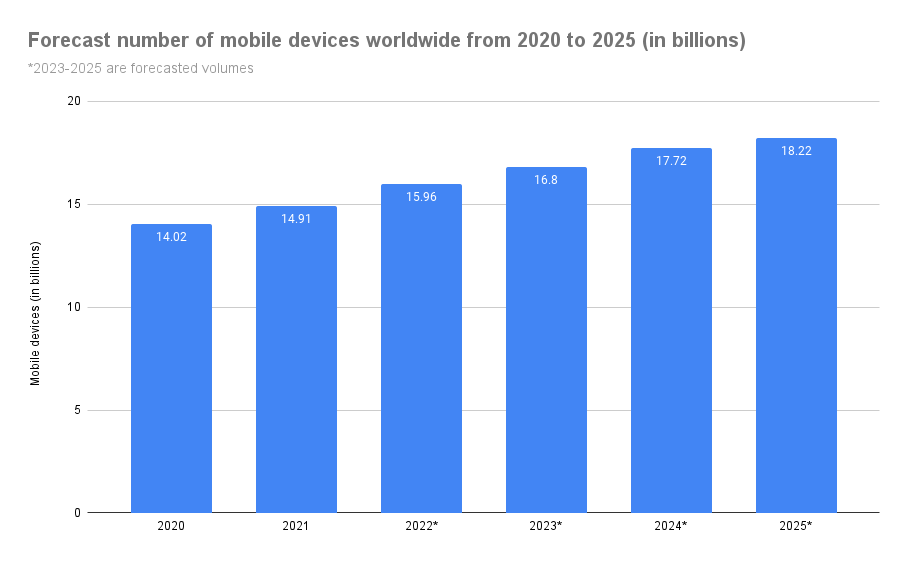
| Forecast number of mobile devices worldwide from 2020 to 2025 (in billions) | |
|---|---|
| Mobile devices (in billions) | |
| 2020 | 14.02 |
| 2021 | 14.91 |
| 2022* | 15.96 |
| 2023* | 16.8 |
| 2024* | 17.72 |
| 2025* | 18.22 |
| *2022-2025 are forecasted volumes | |
- In 2020, there were 14.02 billion mobile devices across the entire globe. By 2023 this figure has risen to 16.80 billion. It is expected to reach 18.22 billion by 2025.
How Many Mobile Phone Owners Exist, Worldwide?
Understanding how many mobile phone owners there are, worldwide, is also crucial for understanding the following data.
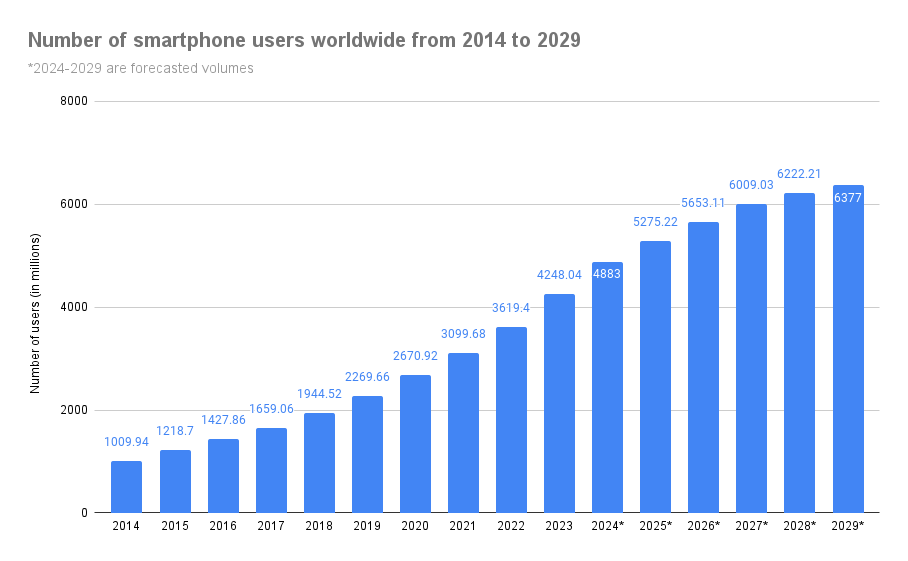
| Number of smartphone users worldwide from 2014 to 2029 | |
|---|---|
| Number of users (in millions) | |
| 2014 | 1009.94 |
| 2015 | 1218.7 |
| 2016 | 1427.86 |
| 2017 | 1659.06 |
| 2018 | 1944.52 |
| 2019 | 2269.66 |
| 2020 | 2670.92 |
| 2021 | 3099.68 |
| 2022 | 3619.4 |
| 2023 | 4248.04 |
| 2024* | 4883 |
| 2025* | 5275.22 |
| 2026* | 5653.11 |
| 2027* | 6009.03 |
| 2028* | 6222.21 |
| 2029* | 6377 |
| *2024-2029 are forecasted volumes | |
- In 2014, there was just over 1 billion smartphone users, worldwide. This number more than doubled to almost 2.3 billion within five years.
- By 2023, there are 4.2 billion smartphone users in the world.
How Many People Die and Leave a Phone, Globally?
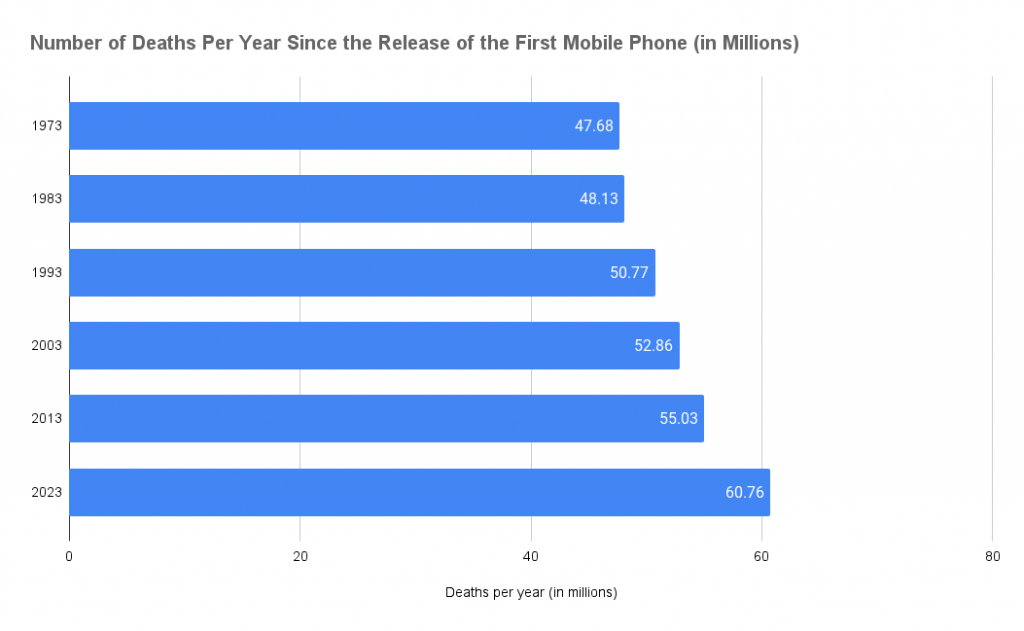
| Number of Deaths Per Year Since The Release of the First Mobile Phone (in Millions) | |
|---|---|
| Deaths per year (in millions) | |
| 1973 | 47.68 |
| 1983 | 48.13 |
| 1993 | 50.77 |
| 2003 | 52.86 |
| 2013 | 55.03 |
| 2023 | 60.76 |
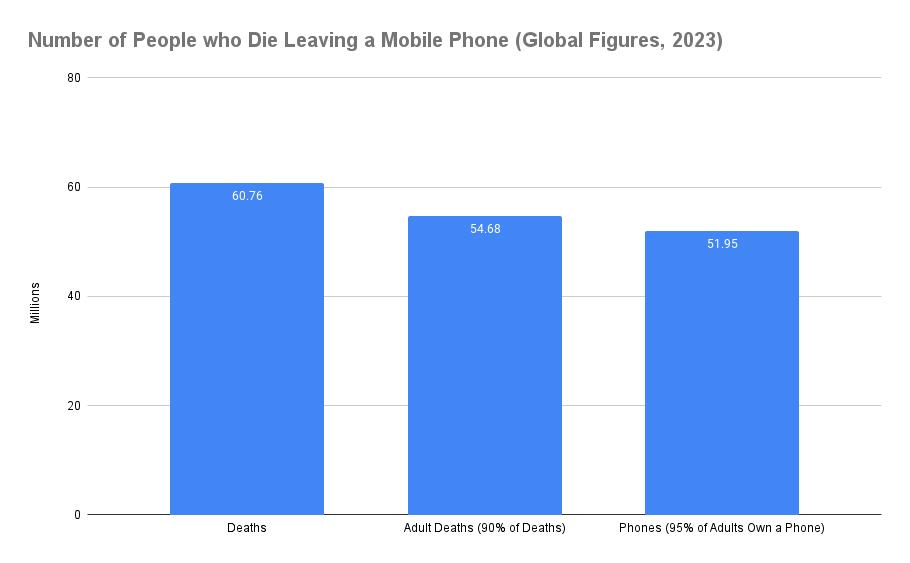
| Number of People who Die Leaving a Mobile Phone (Global Figures, 2023) | |
|---|---|
| Millions | |
| Deaths | 60.76 |
| Adult Deaths (90% of Deaths) | 54.68 |
| Phones (95% of Adults Own a Phone) | 51.95 |
- SellCell analysed data relating to the number of deaths per year, since the first mobile phone was released in 1973 (read more in SellCell’s mobile phone history article).
- In 2023, there were 60.76 million deaths, globally. 90% of these (54.68 million) were adults 1.
- Given that 95% of adults own a phone 9, that means there were 51.95 million orphaned handsets in 2023 alone.
How Many People Die and Leave a Phone in the USA?
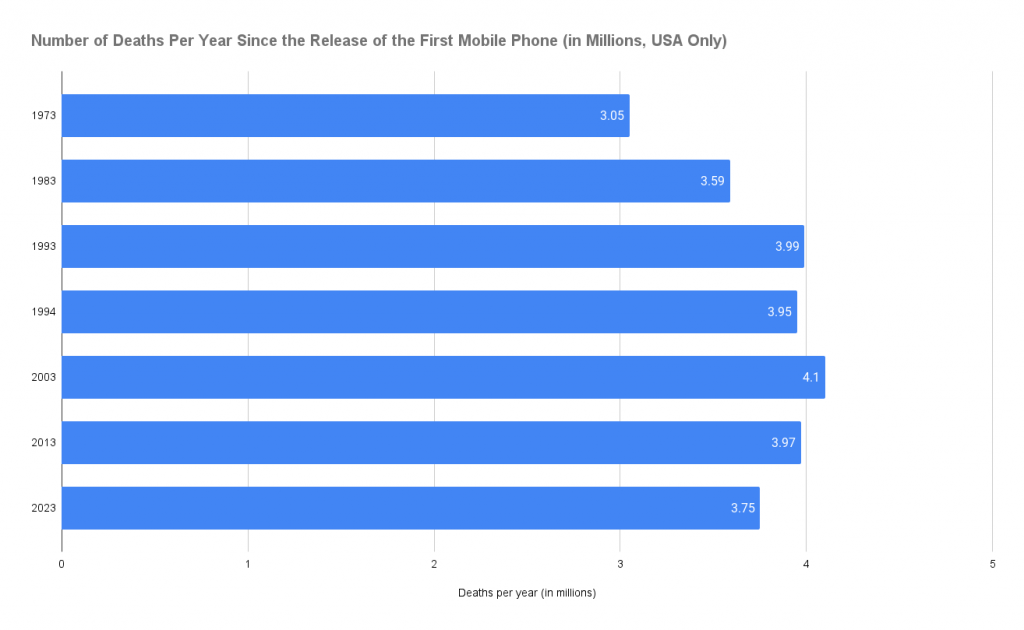
| Number of Deaths Per Year Since The Release of the First Mobile Phone (in Millions, USA Only) | |
|---|---|
| Deaths per year (in millions) | |
| 1973 | 3.05 |
| 1983 | 3.59 |
| 1993 | 3.99 |
| 2003 | 4.10 |
| 2013 | 3.97 |
| 2023 | 3.75 |
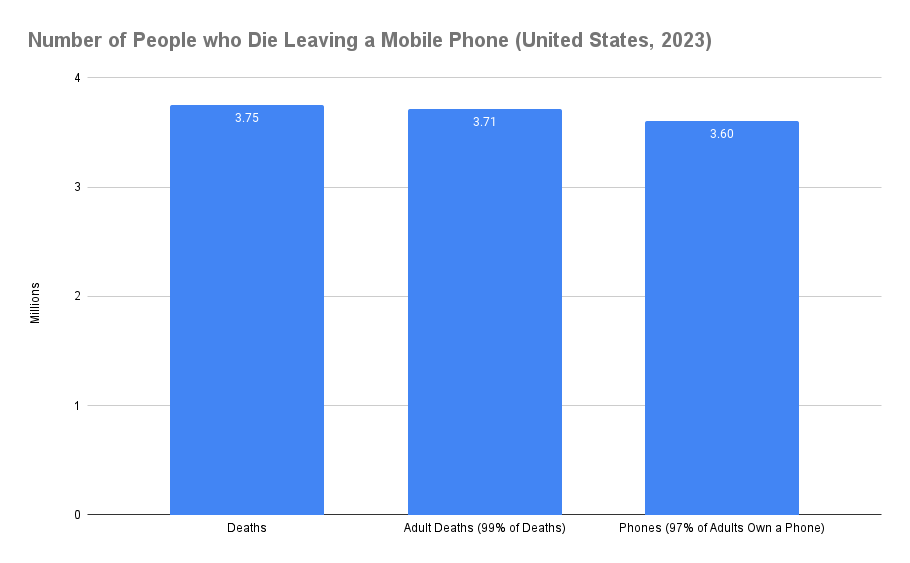
| Number of People who Die Leaving a Mobile Phone (United States, 2023) | |
|---|---|
| Millions | |
| Deaths | 3.75 |
| Adult Deaths (99% of Deaths) | 3.71 |
| Phones (97% of Adults Own a Phone) | 3.60 |
- The USA saw 3.75 million deaths in 2023. 99% of these people were adults, which is 3.71 million 2.
- 97% of US adult citizens own a phone, which means that 2023 alone left 3.60 million orphaned mobile and smartphones.
How Can I Plan to Pass My Phone and Contents on Before I Die?
Planning for the transfer of your phone and digital contents before your passing is a crucial step in ensuring that your digital assets are handled appropriately and accessibly to your loved ones. This process involves various considerations, including password management, legal documentation, and appointing trusted individuals to manage your digital presence.
The best way to ensure those you leave behind have easy access to your digital legacy is to prepare in advance. Here are some tips you can follow to ensure your loved ones can retrieve the information they require:
- Compile a List of Passwords: Before your passing, create a comprehensive list of passwords for all your digital accounts, including email, social media, banking, and any other relevant platforms. Store this list securely and share it with a trusted family member or friend who will handle your digital assets after you’re gone.
- Inform Your Trusted Ones: Make sure your trusted individual(s) know where to find the list of passwords and understand the importance of managing your digital assets according to your wishes. Communicate your preferences regarding the handling of sensitive information and online accounts.
- Document Instructions in Your Will: Include specific instructions regarding the management of your digital assets in your will. Consult with a solicitor to ensure that your will accurately reflects your wishes regarding the transfer of digital contents and provides legal clarity for your appointed executor.
- Appoint a Digital Executor: Nominate a trusted person to serve as your digital executor, responsible for managing your online presence and digital assets according to your instructions. This individual should be tech-savvy and capable of handling various online platforms.
- Utilise a Digital Repository: You can store all your access information in a digital repository. This could be a simple as a password manager tool. Or you could use a specialised digital legacy service management company like DG Legacy, which will release your information to a nominated person upon your passing.
- Set Up Facebook Legacy Contact: If you have a Facebook account, designate a legacy contact through Facebook’s settings. This person will be able to manage your account (e.g., memorialize it or delete it) after your passing, providing a way for your loved ones to commemorate you and handle your digital footprint on the platform.
- Provide Detailed Instructions: Alongside passwords and legal documentation, leave clear and detailed instructions for your nominated individuals regarding the management of specific digital assets, such as sentimental emails, photos, or important documents stored on your devices or in the cloud.
- Regularly Review and Update: Periodically review and update your digital estate plan to account for any changes in your digital footprint, passwords, or preferences. Keeping your plan current ensures that your wishes are accurately represented and can be efficiently executed when the time comes.
By implementing these strategies and considering the various aspects of digital asset management, you can effectively plan for the transfer of your phone and digital contents before you pass away, providing peace of mind for yourself and your loved ones.
What to Do With Someone’s Phone When They Die: 8 Uses for an Orphaned Handset
When faced with the task of handling a deceased person’s phone, it’s essential to approach the matter with sensitivity and diligence. From notifying relevant contacts to safeguarding personal data, navigating the posthumous management of a phone requires careful consideration and adherence to legal and ethical guidelines. This brief guide outlines key steps to ensure a respectful and responsible handling of the deceased individual’s device and associated accounts.
- Contact loved ones: Reach out to notify family and friends about the loss promptly, using the deceased’s smartphone to obtain important numbers of friends that you might not have.
- Preserve memories: Save sentimental photos, messages, and voicemails for remembrance. You can send them to your own phone, or save them to cloud storage.
- Close accounts: Disable social media, email, and other online accounts to prevent unauthorized access. It is easier to close or disable certain accounts from the deceased person’s phone.
- Transfer data: Backup important files and contacts to another device or cloud storage. This would be much the same process as memory preservation, above.
- Give the phone to a loved one: Pass on the device to someone close for sentimental value or utility. A loved one might want to look through the contents of the phone.
- Donate to charity: Give the smartphone to organizations that repurpose electronics for those in need. It is always better to recycle a smartphone than throw the phone in the trash.
- Recycle responsibly: Dispose of the phone properly at electronic recycling centers to minimize environmental impact. You can even send the phone off
- Sell the Orphaned Handset: You can sell the old handset if it is of any value. The money would then go into the deceased person’s estate (or to someone in their will). Utilize websites like SellCell for a hassle-free selling process.
What to Do With a Phone Contract When a Person Dies
When someone passes away, handling their phone contract requires several steps to ensure a smooth transition. Firstly, it’s crucial to inform the phone service provider promptly. They will guide you through the process of closing or transferring the account, which often involves providing a death certificate and other relevant documentation. If the contract is in the deceased person’s name, the account will typically need to be closed, and any outstanding balances settled. This may include paying off the remaining device balance or early termination fees, if applicable.
Alternatively, if another individual wishes to take over the contract, arrangements can be made for a transfer of ownership, depending on the provider’s policies and the existing contractual agreements. It’s advisable to review the terms and conditions of the contract to understand any potential financial obligations and ensure compliance with the provider’s procedures during this sensitive time. Note that not all providers follow the same protocol for dealing with a deceased person’s phone contract.
Here are the steps you should follow when dealing with a deceased person’s phone contract:
- Contact the phone service provider promptly to notify them of the individual’s passing.
- Provide the necessary documentation, such as a death certificate, to the provider as requested.
- Discuss with the provider whether to close the account or transfer ownership to another individual.
- If closing the account, settle any outstanding balances, including device payments or termination fees.
- If transferring ownership, follow the provider’s procedures for transferring the contract to another person’s name.
- Review the terms and conditions of the contract to understand any financial obligations and compliance requirements.
- Keep records of all communications and transactions with the provider for future reference.
- Ensure that any associated devices are returned to the provider if required by the contract terms.
- Consider cancelling any additional services or features associated with the phone contract, such as insurance or data plans.
- Confirm the completion of all necessary steps with the provider and maintain records for personal reference.
I Can’t Get Into the Phone of a Deceased Love One. What Can I Do?
Accessing the phone of a deceased loved one can be a daunting task, particularly if you face password barriers or activation locks. In such situations, it’s crucial to explore options carefully and consider both legal and technical aspects to ensure a smooth process.
From seeking help from service providers and legal resources to exploring manufacturer services and professional expertise, there are various avenues to explore when attempting to access or reset a loved one’s phone. However, it’s essential to proceed with caution, prioritizing privacy, legality, and ethical considerations throughout the journey.
Tips for Accessing a Deceased Loved One’s Phone
- Check for Written Passwords: Look for any written passwords or passcodes that your loved one may have left behind in a safe place, such as a notebook, diary, or password manager.
- Contact Service Providers: Reach out to the service providers associated with the phone, such as the mobile carrier or phone manufacturer. They may have procedures in place for accessing the device or may assist you in navigating legal avenues for access.
- Consult Legal Resources: Seek guidance from legal resources specializing in digital estate planning or posthumous access to digital assets. They can provide advice on navigating legal complexities and obtaining access to the phone through appropriate channels.
- Explore Estate Planning Documents: Review any estate planning documents, such as wills or trusts, for instructions regarding digital asset management. Your loved one may have designated a digital executor or provided guidance on accessing digital devices and accounts.
- Consider Probate Court: If necessary, consider initiating the probate process to obtain legal authority over your loved one’s digital assets, including their phone. Probate court can grant permissions for accessing digital accounts and devices as part of the estate settlement process.
- Utilize Manufacturer Services: Some phone manufacturers offer services for accessing devices in cases of bereavement or emergency. Contact the manufacturer’s customer support or explore their online resources to inquire about available options.
- Seek Professional Assistance: If all else fails, consider consulting with forensic experts or professional services specializing in digital forensics and data recovery. These experts may have the technical capabilities to access the phone’s contents, even if the password is unknown.
Resetting the Device Without a Password
If you’re unable to access the phone because of a forgotten password or activation lock, the options for resetting the device may be limited. However, here are some avenues to explore:
- Contact the Manufacturer: Reach out to the phone manufacturer’s customer support for guidance on resetting the device without the password. They may have procedures or tools available to assist with bypassing security measures in certain circumstances.
- Use Recovery Mode: For some devices, entering recovery mode may allow you to reset the device to factory settings, effectively removing the password lock. However, be aware that this process may result in data loss, so proceed with caution.
- Consult Third-Party Services: There are third-party services and tools available that claim to assist with unlocking devices or bypassing activation locks. Exercise caution when using these services and ensure they are reputable and legitimate to avoid potential scams or further complications.
- Consider Professional Assistance: If resetting the device proves challenging or risky, consider seeking assistance from professional technicians or mobile device repair specialists. They may have the expertise to safely reset the device or retrieve data without causing damage.
Ultimately, while there are avenues to explore for accessing a deceased loved one’s phone or resetting it without the password, it’s essential to prioritize legal compliance, data privacy, and ethical considerations throughout the process. Planning ahead and having open conversations about digital estate planning can help ease potential challenges for loved ones in the future.
Is it Legal to Access a Person’s Digital Data When They Die?
Understanding how to access someone’s digital life after they pass away can be quite complicated. Right now, there isn’t one clear set of rules in the majority of countries, like the UK and the US, for inheriting digital assets. Instead, it often depends on what each service provider stipulates in their terms of service.
These rules usually only let the person who owned the account gain access to it, which makes it difficult for family or friends to access things like emails or social media. Some countries are starting to make specific laws or guidelines for such eventualities, but it’s still a minefield for any bereaved individual. So, dealing with a loved one’s digital assets after they’re gone can be incredibly complicated, showing how important it is to have clear guidelines for this in the future.
The Digital Devices (Access for Next of Kin) Bill, recently presented to the UK House of Commons by DUP MP Ian Paisley 7, holds promise for facilitating access to a deceased person’s digital assets, heralding a significant step forward in addressing the complexities surrounding posthumous digital inheritance. He states that there is an estimated £25 billion in digital assets in the UK alone. Under current regulations, access to such assets would be difficult for anyone but the owner.
By establishing a legal framework that enables next of kin to access digital assets such as online accounts, social media profiles, and digital files, the proposed legislation aims to alleviate the burden on grieving families grappling with bureaucratic hurdles and technological barriers.
This initiative represents a crucial modernization of inheritance laws, acknowledging the increasingly digital nature of our lives and ensuring that individuals have the means to manage their digital legacies in a manner consistent with their wishes. Simplifying access to digital assets not only streamlines the inheritance process but also fosters greater peace of mind and closure for loved ones left behind, underscoring the importance of adapting legal frameworks to reflect the evolving digital landscape.
How to Deal With a Deceased Person’s Digital Presence: Useful Links
Here’s a list of phone service providers and their web pages, plus other useful services, to assist with what to do with a deceased person’s phone contract and digital accounts:
- AT&T: Deceased account handling 10
- Verizon:
- T-Mobile: Cancel an account of a deceased family member 13
- Apple: Guide to accessing a family member’s Apple account after they have passed away 14
- Google: Guide to accessing a family member’s Google account after they have passed away 15
- Microsoft: Guide to accessing a family member’s Microsoft account after they have passed away 16
- Facebook: Legacy contacts 17 (this tool allows you to choose what happens to your profile when you die)
- Twitter: Guide to help you close or deactivate a deceased person’s account 18
- Amazon: Guide to help you close or deactivate a deceased person’s account 19
- Spotify: Closing someone’s Spotify account in the event of their death 20
- Instagram:
- Digital Legacy Services: DG Legacy 23 – Helps you pass on your digital assets to a loved one in the event of your death.
Additionally, here are resources for managing digital assets in a will and setting up partner sharing for Google Photos and family/group sharing in OneDrive:
- Leaving digital assets in your will 24
- Partner sharing for Google Photos 25
- Family and group sharing in OneDrive 26
While it doesn’t cover everything, the list above should provide some signposts to assist if you are currently dealing with a deceased person’s digital legacy.
Leaving a Digital Legacy: What Happens to your Phone (and Your Other Digital Data) When You Die?
As we can see from the article above, the process of dealing with a deceased person’s mobile phone, and associated digital legacy, can be a complicated one. What happens to a person’s phone when they die? Well, that, along with the rest of their personal effects, generally form part of the estate of the deceased. Much like with digital data, it is important to plan ahead, and decide what you want to happen to your phone and your digital life when you pass away. It might sound nihilistic to think of such things, but it will make life easier for the loved ones you leave behind.
